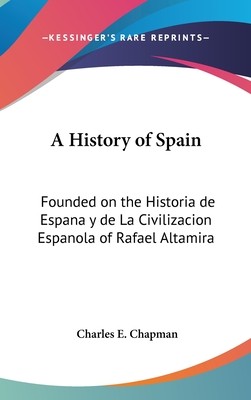
- We will send in 10–14 business days.
- Author: Charles E Chapman
- Publisher: Kessinger Publishing
- ISBN-10: 1436697468
- ISBN-13: 9781436697460
- Format: 15.2 x 22.9 x 3.7 cm, hardcover
- Language: English
Reviews
Description
Excerpt:
We have some one-volume histories of Spain in Castilian which are to be recommended for the needs of our own secondary schools, but not for those of a foreign country, whose students require another manner of presentation of our history, for they have to apply an interrogatory ideal which is different from ours in their investigation of the deeds of another people, -all the more so if that people, like the Spanish, has mingled in the life of nearly the whole world and been the victim of the calumnies and fanciful whims of historians, politicians, and travellers. ...X), in my lectures on the history of Spain in the nineteenth century (given at the Ateneo of Madrid, some years ago), in the little manual of the Historia de la civilizacion espanola (History of Spanish civilization) which goes to the year 1898, and even in the second part of a recent work, Espana y el programa americanista (Spain and the Americanist program), published at Madrid in 1917, nevertheless could not avail itself of a single text, a continuous, systematized account, comprehensive of all the aspects of our national life as in the case of the periods prior to 1808. ...At about the point where the Pyrenees proper and the Cantabrian Mountains come together the Iberian, or Celtiberian, range, a series of isolated mountains for the most part, breaks off to the southeast until near the Mediterranean, when it curves to the west, merging with the Penibetica range (better known as the Sierra Nevada Mountains, the name of that part of the range lying south of the city of Granada), which moves westward near the southern coast to end in the cape of Tarifa.
- Author: Charles E Chapman
- Publisher: Kessinger Publishing
- ISBN-10: 1436697468
- ISBN-13: 9781436697460
- Format: 15.2 x 22.9 x 3.7 cm, hardcover
- Language: English English
Excerpt:
We have some one-volume histories of Spain in Castilian which are to be recommended for the needs of our own secondary schools, but not for those of a foreign country, whose students require another manner of presentation of our history, for they have to apply an interrogatory ideal which is different from ours in their investigation of the deeds of another people, -all the more so if that people, like the Spanish, has mingled in the life of nearly the whole world and been the victim of the calumnies and fanciful whims of historians, politicians, and travellers. ...X), in my lectures on the history of Spain in the nineteenth century (given at the Ateneo of Madrid, some years ago), in the little manual of the Historia de la civilizacion espanola (History of Spanish civilization) which goes to the year 1898, and even in the second part of a recent work, Espana y el programa americanista (Spain and the Americanist program), published at Madrid in 1917, nevertheless could not avail itself of a single text, a continuous, systematized account, comprehensive of all the aspects of our national life as in the case of the periods prior to 1808. ...At about the point where the Pyrenees proper and the Cantabrian Mountains come together the Iberian, or Celtiberian, range, a series of isolated mountains for the most part, breaks off to the southeast until near the Mediterranean, when it curves to the west, merging with the Penibetica range (better known as the Sierra Nevada Mountains, the name of that part of the range lying south of the city of Granada), which moves westward near the southern coast to end in the cape of Tarifa.


Reviews